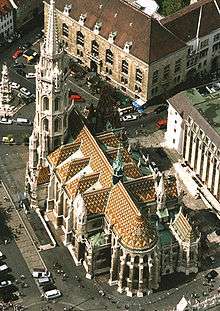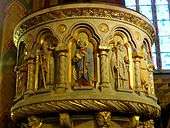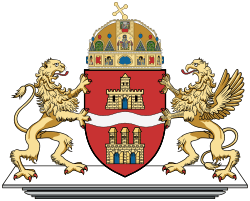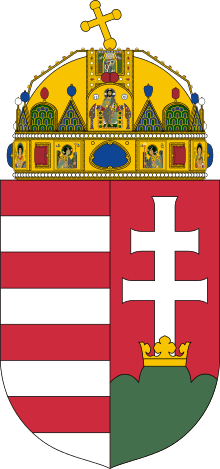Matthias Church
| Matthias Church | |
|---|---|
|
Church of Our Lady of Buda Hungarian: Budavári Nagyboldogasszony-templom | |
| Hungarian: Mátyás-templom | |
 | |
| Location | Budapest |
| Country | Hungary |
| Denomination | Roman Catholic |
| Website |
www |
| History | |
| Status | Parish church |
| Founded | 11th century |
| Founder(s) | Saint Stephen of Hungary |
| Architecture | |
| Functional status | Active |
| Years built |
11th century 15th century (rebuilt) |
| Specifications | |
| Number of towers | 1 |
| Bells | 3 (surviving) |
| Administration | |
| Archdiocese | Esztergom-Budapest |
| Clergy | |
| Rector | László Süllei[1] |
| Laity | |
| Organist(s) | Bertalan Hock (hu) |
Matthias Church (Hungarian: Mátyás-templom) is a Roman Catholic church located in Budapest, Hungary, in front of the Fisherman's Bastion at the heart of Buda's Castle District. According to church tradition, it was originally built in Romanesque style in 1015, although no archaeological remains exist.[2] The current building was constructed in the florid late Gothic style in the second half of the 14th century and was extensively restored in the late 19th century. It was the second largest church of medieval Buda and the seventh largest church of the medieval Hungarian Kingdom.
History


The first church on the site was founded by Saint Stephen, King of Hungary in 1015. This building was destroyed in 1241 by the Mongols; the current building was constructed in the latter half of the 13th century.[3] Originally named after the Virgin Mary, taking names such as "The Church of Mary" and "The Church of Our Lady," Matthias Church was named after King Matthias in the 19th Century, who ordered the transformation of its original southern tower.[4][5]
The church was the scene of several coronations, including that of Charles IV in 1916 (the last Habsburg king). It was also the site for King Matthias's two weddings (the first to Catherine of Poděbrady and, after her death, to Beatrice of Naples). During the century and a half of Turkish occupation, the vast majority of its ecclesiastical treasures were shipped to Pressburg (present day Bratislava) and following the capture of Buda in 1541 the church became the city's main mosque. Ornate frescoes that previously adorned the walls of the building were whitewashed and interior furnishings stripped out.
The church was also the location of the "Mary-wonder." In 1686 during the siege of Buda by the Holy League a wall of the church collapsed due to cannon fire. It turned out that an old votive Madonna statue was hidden behind the wall. As the sculpture of the Virgin Mary appeared before the praying Muslims, the morale of the garrison collapsed and the city fell on the same day.[6]
Although following Turkish expulsion in 1686 an attempt was made to restore the church in the Baroque style, historical evidence shows that the work was largely unsatisfactory. It was not until the great architectural boom towards the end of the 19th century that the building regained much of its former splendour. The architect responsible for this work undertaken in 1873-96 was Frigyes Schulek.[2]
The church was restored to its original 13th-century plan, but a number of early original Gothic elements were uncovered. By also adding new motifs of his own (such as the diamond pattern roof tiles and gargoyles laden spire) Schulek ensured that the work, when finished, would be highly controversial.[7]
The church was the venue for the coronation of the last two Hungarian Habsburg kings, Franz Joseph in 1867 and Charles IV in 1916.[8]
During World War II the church was badly damaged. Matthias Church was used as a camp by the Germans and Soviets in 1944–45 during the Soviet occupation of Hungary. The church was largely renovated between 1950 and 1970 with funding from the Hungarian government. The bell tower was restored, along with renovation of interior paints and frescos.[9] The five-manual organ, which had been destroyed during the war, was updated and sanctified in 1984.[10]
A thorough restoration programme was carried out from 2006 to 2013. Half of the HUF 9.4 billion cost was met by the government.[11]
It is home to the Ecclesiastical Art Museum, which begins in the medieval crypt and leads up to the St. Stephen Chapel. The gallery contains a number of sacred relics and medieval stone carvings, along with replicas of the Hungarian royal crown and coronation jewels.[12]
Pulpit

The pulpit of the church was built between 1890 and 1893 during the extensive reconstruction of the building. It was designed by Frigyes Schulek with the help of art historian Béla Czobor who contributed to the draft of the iconographic plan. The statues were carved by Ferenc Mikula, the abat-voix was made by Károly Ruprich.
The pulpit was built of sandstone, and the surfaces are entirely covered with Neo-Romanesque ornamental painting including the statues. There is a wrought-iron rail at the bottom of the steps. The Gothic Revival abat-voix, resembling a medieval tower, was carved of oak and the statue of the Good Shepherd on the top was made of linden. The platform of the pulpit is supported by an outer ring of arches and a massive central pillar. The most interesting part of the structure is the sculptural decoration of the parapet with the statues of the four evangelists and the four Latin doctors of the church standing under the arches of a blind arcade. The sequence of the figures is:

- St John with the eagle
- St Augustine with the boy
- St Luke with the ox
- St Ambrose with the beehive
- St Mark with the lion
- St Gregory the Great with the dove
- St Matthew with the angel
- St Jerome with the lion
The two bishops and the saintly pope are portrayed in the traditional attire of their office, and Jerome is wearing cardinal robes. The parapet is supported by brackets decorated with grotesque heads in medieval style, and framed by two bands of carved vegetal decoration (vine and acanthus leaves).
Previous pulpits
The first recorded pulpit was erected in 1693 after the reconversion of the building from mosque to church under the ownership of the Jesuits. Nothing is known about its appearance. A new Baroque pulpit was installed in 1769 by Countess Erzsébet Berényi, the owner of the Zichy estate of Óbuda. This was probably made by Károly Bebo, the stewart and sculptor of the estate who made several high-quality Baroque pulpits in the region, including those in the parish church of Óbuda and the Trinitarian church of Kiscell. His work in the Matthias Church was recorded by a litograph of Gusztáv Zombory (1857) and the only surviving photograph of the interior of the church before its extensive reconstruction.
Bebo's lost work should have been a fine example of Central-European Baroque wood carving. The pulpit itself was decorated with reliefs and two statues of prophets (perhaps Moses and Aaron) and two angels sitting on its ledge. The canopy of the abat-voix was supported by two flying angels. There was a statue of the Risen Christ on the top surrounded with cherubs. The old pulpit was demolished by Frigyes Schulek immediately after the closure of the church in 1876 at the start of the long reconstruction. Only two figures of flying cherubs survived, which were probably parts of the structure, the first one in the Hungarian National Gallery and the other in the collection of the parish church.
The church bells
Today the church has 7 bells. Six of them are located in the bell tower and the last damaged bell hangs in the cavalry tower. Two of the tower's bells are historic bells. The church got 4 new bell in 2010, then the Szt. Károly bell sound correction took place.
Burials
Honors
Stamps issued by Hungary; on 24 January 1927[13], on 26 March 1926[14] and in 1930[15].
Gallery
Notes
- ↑ Our Parish
- 1 2 http://www.budapestbylocals.com/matthias-church.html
- ↑ Matthias-templom.hu, The Church: History: XIII, Accessed 29 Nov 2014
- ↑ Matyas-templom.hu, History: The Church: 1015, accessed 29 Nov 2014
- ↑ Cannon, Gwen (2008). Hungary, Budapest (New ed.). Clermont-Ferrand: Michelin. pp. 126–128. ISBN 978-1-906261-18-4.
- ↑ MAtthias-templom.hu, The Church: History: 1686
- ↑ http://www.szakinfo.hu/matyas-templom/eng/ind_tort.htm
- ↑ http://www.sacred-destinations.com/hungary/budapest-matthias-church
- ↑ Matthias-templom.hu, History: The Church: 1950–1970
- ↑ Matthias-templom.hu, The Church: History: 1984, Accessed 29 Nov 2014
- ↑ http://budapesttimes.hu/2013/10/25/mat%C2%ADthias-church-back-to-its-crowning-glory/
- ↑
- ↑ https://colnect.com/en/stamps/stamp/180761-Matthias_Church-Matthias_Church-Hungary
- ↑ https://colnect.com/en/stamps/stamp/252089-Matthias_Church_wmk_8_perf_14-Matthias_Church-Hungary
- ↑ https://colnect.com/en/stamps/stamp/252100-Matthias_Church_wmk_9_perf_15-Matthias_Church-Hungary
References
- Schneider, Rolf (2004). Manfred Leier, ed. 100 most beautiful cathedrals of the world: A journey through five continents. trans. from German by Susan Ghanouni and Rae Walter. Edison, New Jersey: Chartwell Books. pp. 104–105.
External links
| Wikimedia Commons has media related to Matthias Church (Budapest). |
Coordinates: 47°30′07″N 19°02′03″E / 47.50194°N 19.03417°E

.jpg)


